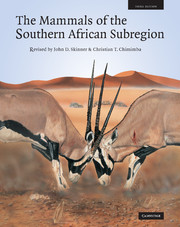Book contents
- Frontmatter
- Contents
- Editorial board
- Acknowledgements
- Foreword
- Preface
- The Mammal Research Institute
- R. H. N. Smithers
- Explanatory notes
- SUPERCOHORT AFROTHERIA
- COHORT PAENUNGULATA
- SUPERCOHORT EUARCHONTAGLIRES COHORT GLIRES
- COHORT EUARCHONTA
- SUPERCOHORT LAURASIATHERIA
- Order EULIPOTYPHLA
- Order CHIROPTERA / Bats
- COHORT FERUNGULATA
- Bibliography
- Appendix 1 Conservation status of southern African mammals
- Appendix 2 Colloquial names
- Index of scientific names
- Index of English colloquial names
- List of subscribers
- Plate Section
- Plate Section
- Plate Section
- Plate Section
- Plate Section
- Plate Section
- Plate Section
Order CHIROPTERA / Bats
from SUPERCOHORT LAURASIATHERIA
Published online by Cambridge University Press: 05 July 2013
- Frontmatter
- Contents
- Editorial board
- Acknowledgements
- Foreword
- Preface
- The Mammal Research Institute
- R. H. N. Smithers
- Explanatory notes
- SUPERCOHORT AFROTHERIA
- COHORT PAENUNGULATA
- SUPERCOHORT EUARCHONTAGLIRES COHORT GLIRES
- COHORT EUARCHONTA
- SUPERCOHORT LAURASIATHERIA
- Order EULIPOTYPHLA
- Order CHIROPTERA / Bats
- COHORT FERUNGULATA
- Bibliography
- Appendix 1 Conservation status of southern African mammals
- Appendix 2 Colloquial names
- Index of scientific names
- Index of English colloquial names
- List of subscribers
- Plate Section
- Plate Section
- Plate Section
- Plate Section
- Plate Section
- Plate Section
- Plate Section
Summary
Classification
THE ORDER CHIROPTERA is divided into two suborders, the Megachiroptera, the fruit eaters, and the Microchiroptera, the insect eaters. Some 177 genera and 925 bat species are listed in the order (Koopman, 1993), of which only 33 genera and 76 species occur in the subregion (Taylor, 2000; Bronner et al., 2003).
The fossil record
The earliest known fossil bat was discovered in the Early Eocene deposits in America (Jepsen, 1966). In relative dating this is 75 million years after the appearance of the first mammals. From the structure of its teeth and skeleton it was certainly an insect eater although, unlike present–day insect–eating bats, it had two claws on the forearm – one on the thumb, the other on the first finger – which is characteristic of modern fruit eaters. In all respects, however, it closely resembled bats as we know them today, but gives us no clues about the origin of flight in the order or the origin of bats prior to this time.
The oldest fossil bat known from Africa is Vampyravus orientalis, which was recovered from the Oligocene deposits of Egypt, but whose relationships remain problematic. For a long time it was thought that bats were related to the Tupaiidae, the tree shrews, a family of the Order Scandentia, which occurs in Asia and India, and to the Order Dermoptera, the flying lemurs of the Far East, and that the Chiroptera and Insectivora evolved from a common, probably arboreal, ancestor (Anderson & Jones, 1967).
- Type
- Chapter
- Information
- The Mammals of the Southern African Sub-region , pp. 256 - 357Publisher: Cambridge University PressPrint publication year: 2005
- 4
- Cited by

